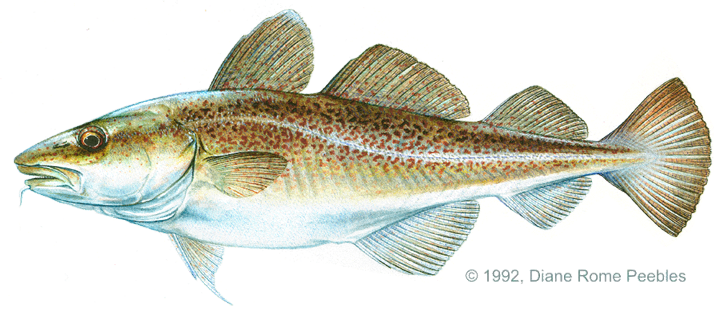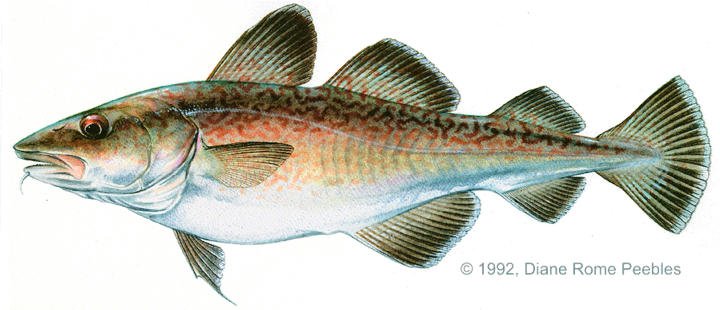Game Fish Identification Reference Guides
Cod, Atlantic
(Gadus morhua)
(Gadus morhua)

Linnaeus, 1758; GADIDAE FAMILY; also called codfish, codling
Occurs in subarctic and cool temperate waters of the North Atlantic from Greenland to North Carolina, including the Hudson Strait, and from Novaya Zemlya, in the former U.S.S.R., to the northern reaches of the Bay of Biscay, including the Baltic and North seas and Iceland. The cod can be found in depths of up to 200 fathoms and prefers rough bottoms composed of sand and rock or of shells. It is migratory though the extent of its migration varies among stocks.
The cod can be distinguished from other members of its family by the large barbel on the chin and the arch in the lateral line. Like many other members of its family they have three separate dorsal fins and two separate anal fins, none of which contain any spines. The back and sides are highly variable in color (ranging from brownish or sandy to gray, yellow, reddish, greenish, or any combination), and mottled with numerous lighter spots. The belly is white, the lateral line is pale, and all the fins are dark.
Largely omnivorous, they feed on herring, sprat, capelin, sand eels, Irish moss, etc. Many unusual items have also been found in the stomachs of adult cod, including an oil can, a rubber doll, finger rings, clothing, and some very rare deep sea shells that were previously unknown to science.
Most cod taken by anglers are caught by bait fishing on the bottom from a drifting or anchored boat, but many are taken by jigging and deep trolling as well. Cod have large mouths, so hook size may vary, but the bait need not be large—a good sized ocean clam will do for almost any size cod. Other good baits include strip baits of squid, fish, crabs, sand eels, and capelin. Artificial lures such as chrome diamond jigs, spinners, bucktails, spoons, and shiny metal squids may also be used.
The largest cod known to have been caught weighed 211 lb 8 oz (95.90 kg) and was taken in May of 1895 off the coast of Massachusetts. It was over 6 ft (1.8 m) long. Possibly due to relentless fishing pressure, the average size of cod today is only 4 15 lb (2 7 kg) and specimens weighing over 60 lb (27 kg) are unusual. It would be difficult to overstate the cod's value as a food fish
Occurs in subarctic and cool temperate waters of the North Atlantic from Greenland to North Carolina, including the Hudson Strait, and from Novaya Zemlya, in the former U.S.S.R., to the northern reaches of the Bay of Biscay, including the Baltic and North seas and Iceland. The cod can be found in depths of up to 200 fathoms and prefers rough bottoms composed of sand and rock or of shells. It is migratory though the extent of its migration varies among stocks.
The cod can be distinguished from other members of its family by the large barbel on the chin and the arch in the lateral line. Like many other members of its family they have three separate dorsal fins and two separate anal fins, none of which contain any spines. The back and sides are highly variable in color (ranging from brownish or sandy to gray, yellow, reddish, greenish, or any combination), and mottled with numerous lighter spots. The belly is white, the lateral line is pale, and all the fins are dark.
Largely omnivorous, they feed on herring, sprat, capelin, sand eels, Irish moss, etc. Many unusual items have also been found in the stomachs of adult cod, including an oil can, a rubber doll, finger rings, clothing, and some very rare deep sea shells that were previously unknown to science.
Most cod taken by anglers are caught by bait fishing on the bottom from a drifting or anchored boat, but many are taken by jigging and deep trolling as well. Cod have large mouths, so hook size may vary, but the bait need not be large—a good sized ocean clam will do for almost any size cod. Other good baits include strip baits of squid, fish, crabs, sand eels, and capelin. Artificial lures such as chrome diamond jigs, spinners, bucktails, spoons, and shiny metal squids may also be used.
The largest cod known to have been caught weighed 211 lb 8 oz (95.90 kg) and was taken in May of 1895 off the coast of Massachusetts. It was over 6 ft (1.8 m) long. Possibly due to relentless fishing pressure, the average size of cod today is only 4 15 lb (2 7 kg) and specimens weighing over 60 lb (27 kg) are unusual. It would be difficult to overstate the cod's value as a food fish













